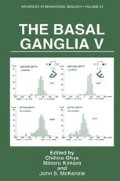Abstract
Mesencephalic dopaminergic neurons possess receptors for their own neurotransmitter, dopamine, at both somatodendritic as well as axon terminal regions. These receptors are termed autoreceptors and act to modulate dopaminergic synaptic transmission in two ways. Activation of the somatodendritic autoreceptors produces a membrane hyperpolarization by increasing a potassium conductance (Lacey, 1993) which leads to an inhibition of spontaneous activity (Groves et al., 1975). Activation of the terminal autoreceptors produces a decrease in terminal excitability which is presumed to reflect a membrane hyperpolarization (Tepper et al., 1985) which leads to a reduction in dopamine synthesis and in calcium- and impulse-dependent release of dopamine from nerve terminals (Starke et al., 1989; Wolf and Roth, 1987).
Access this chapter
Tax calculation will be finalised at checkout
Purchases are for personal use only
Preview
Unable to display preview. Download preview PDF.
References
Akaoka, H., Charléty, P., Saunier, C.-F., Buda, M., & Chouvet, G. (1992) Inhibition of nigral dopaminergic neurons by systemic and local apomorphine: possible contribution of dendritic autoreceptors. Neuroscience 49:879–892.
Boyar, W.C., & Altar, C.A. (1987) Modulation of in vivo dopamine release by D2 but not D1 receptor agonists and antagonists. J. Neurochem. 48:824–831.
Diaz, J., Lévesque, D., Lammers, C.H., Griffon, N., Martres, M.-P., Schwartz, J.-C., & Sokoloff, P. (1995) Phenotypical characterization of neurons expressing the dopamine D3 receptor in the rat brain. Neuroscience 65:731–795.
Giros, B., Sokoloff, P., Martres, M.-P., Riou, J.-F., Emorine, L.J., & Schwartz, J.C. (1989) Alternative splicing directs the expression of two D2 dopamine receptor isoforms. Nature (Lond.) 342:923–926.
Groves, P.M., Wilson, C.J., Young, S.J., & Rebec, G.V. (1975) Self-inhibition by dopaminergic neurons. Science 190:522–529.
Kebabian, J.W., & Calne, D.B. (1979) Multiple receptors for dopamine. Nature (Lond.) 277:93–96.
Kreiss, D.S., Bergstron, D.A., Gonzalez, A.M., Huang, K-.X., Sibley, D.R., & Walters, J.R. (1995). Dopamine receptor agonist potencies for inhibition of cell firing correlate with dopamine D3 receptor binding affinities. Eur. J. Pharmacol. 277:209–214.
Lacey, M.G. (1993) Neurotransmitter receptors and ionic conductances regulating the activity of neurones in substantia nigra pars compacta and ventral tegmental area. In: G.W. Arbuthnott and P.C. Emson (Eds.) Chemical Signalling in the Basal Ganglia, Progress in Brain Research, Volume 99, pp. 251–276.
Lejeune, F., & Millan, M.J. (1995) Activation of dopamine D3 autoreceptors inhibits firing of ventral tegmental dopaminergic neurones in vivo. Eur. J. Phamacol. 275:R7–R9.
Martin, L.P., Kita, H., Sun, B.-C., Zhang, M., Creese, I., & Tepper, J.M. (1994) Electrophysiological consequences of D2 receptor antisense knockout in nigrostriatal neurons. Soc. Neurosci. Abstr. 20:908.
Matsuda, Y., & Jinnai, K. (1980) Afferent inputs to caudate output neurons as monitored by antidromic spike invasion of the cell soma. Brain Res. 188: 560–565
Meller, E., Bohmaker, K., Goldstein, M., & Basham, D.A. (1993) Evidence that striatal synthesis-inhibiting autoreceptors are dopamine D3 receptors. Eur. J. Pharmacol. 249:R5–R6.
Monsma, F.J., Jr., McVittie, L.D., Gerfen, C.R., Mahan, L.C., & Sibley, D.R. (1989) Multiple D2 dopamine receptors produced by alternative RNA splicing. Nature (Lond.) 342:926–929.
Morelli, M., Mennini, T., & Di Chiara, G. (1988) Nigral dopamine autoreceptors are exclusively of the D2 type: Quantitative autoradiography of [125I]iodosulpiride and [125I]SCH23892 in adjacent brain sections. Neuroscience 27:865–870.
Nissbrandt, H., Ekman, A., Eriksson, E., & Heilig, M. (1995) Dopamine D3 receptor antisense influences dopamine synthesis in rat brain. Neuroreport 6:573–576.
Schwartz, J.C., Giros B., Martres, M.P., Sokoloff, P. (1992) The dopamine receptor family: molecular biology and pharmacology. Seminars in The Neurosciences 4:99–108
Sibley, D.R., & Monsma Jr., F.J. (1992) Molecular biology of dopamine receptors. Trends Pharmacol. Sci. 13:61–69.
Skirboll, L.R., Grace, A.A., & Bunney, B.S. (1979) Dopamine auto-and postsynaptic receptors: Electro-physiological evidence for differential sensitivity to dopamine agonists. Science 206:80–82.
Sokoloff, P., Giros, B., Martres, M.-R, Bouthenet, M.-L., & Schwartz, J.-C. (1990) Molecular cloning and characterization of a novel dopamine receptor (D3) as a target for neuroleptics. Nature (Lond.) 347:146–151.
Starke, K., Gothert, M. & Kilbinger, H. (1989) Modulation of neurotransmitter release by presynaptic autoreceptors. Physiol. Rev. 59:864–989.
Sun, B.-C., Creese, I., & Tepper, J.M. (1995) Electrophysiology of antisense knockout of D2 and D3 dopamine receptors in nigrostriatal dopamine neurons. Soc. Neurosci. Abstr. 21:1661.
Sun, B.-C., Martin, L.P., Creese, I., & Tepper, J.M. (1996) Functional roles of dopamine D2 autoreceptors in nigrostriatal neurons analyzed by antisense knockout in vivo. (submitted).
Tang, L., Todd, R.D., & O’Malley, K.L. (1994) Dopamine D2 and D3 receptors inhibit dopamine release. J. Pharmacol. Exp. Then 270:415–479.
Tepper, J.M., Groves, P.M., & Young, S.J. (1985) The neuropharmacology of the autoinhibition of monoamine release. Trends Pharmacol. Sci. 6:251–256.
Tepper, J.M., Martin, L.R. & Anderson, D.R. (1995) GABAA receptor-mediated inhibition of nigrostriatal dopaminergic neurons by pars reticulata projection neurons. J. Neurosci. 5:3092–3103.
Tepper, J.M., Nakamura, S., Young, S.J., & Groves, P.M. (1984) Autoreceptor-mediated changes in dopaminergic terminal excitability: Effects of striatal drug infusions. Brain Res. 309:311–333.
Trent, F., & Tepper, J.M. (1991) Dorsal raphé stimulation modifies striatal-evoked antidromic invasion of nigral dopaminergic neurons in vivo. Exp. Brain Res. 84:620–630.
Wolf, M.E., & Roth, R.H. (1990) Autoreceptor regulation of dopamine synthesis. In: S. Kalsner and T.C. Westfall, (Eds.) Presynaptic Autoreceptors and the Question of the Autoregulation of Neurotransmitter Release. Ann. New York Acad. Sci. 604:323–343.
Zhang, M., & Creese, I. (1993) Antisense oligodeoxynucleotide reduces brain dopamine D2 receptors: behavioral correlates. Neurosci. Lett. 161:223–226.
Zhang, M., Ouagazzal, A., & Creese, I. (1996) Regulation of motor behavior by dopamine receptor subtypes: an antisense knockout approach. In: K. Neve and R. Neve (Eds.), The Dopamine Receptors, Humana Press, In press.
Author information
Authors and Affiliations
Editor information
Editors and Affiliations
Rights and permissions
Copyright information
© 1996 Springer Science+Business Media New York
About this chapter
Cite this chapter
Tepper, J.M., Sun, BC., Martin, L.P., Creese, I. (1996). Electrophysiological Consequences of D2 and/or D3 Receptor Knockout by Antisense Oligonucleotides in Nigrostriatal Dopaminergic Neurons. In: Ohye, C., Kimura, M., McKenzie, J.S. (eds) The Basal Ganglia V. Advances in Behavioral Biology, vol 47. Springer, Boston, MA. https://doi.org/10.1007/978-1-4899-0194-1_16
Download citation
DOI: https://doi.org/10.1007/978-1-4899-0194-1_16
Publisher Name: Springer, Boston, MA
Print ISBN: 978-1-4899-0196-5
Online ISBN: 978-1-4899-0194-1
eBook Packages: Springer Book Archive

